Many of us love peace lilies (Spathiphyllum spp.) for their stunning white flowers, but even when they’re not in bloom, these houseplants are remarkably beautiful.
I’d grow peace lilies even if they didn’t bloom – those glossy, elegant green leaves are pretty irresistible.
That is, unless the foliage starts to look less than stellar, which can happen when the tips of the leaves turn brown, a fairly common occurrence.
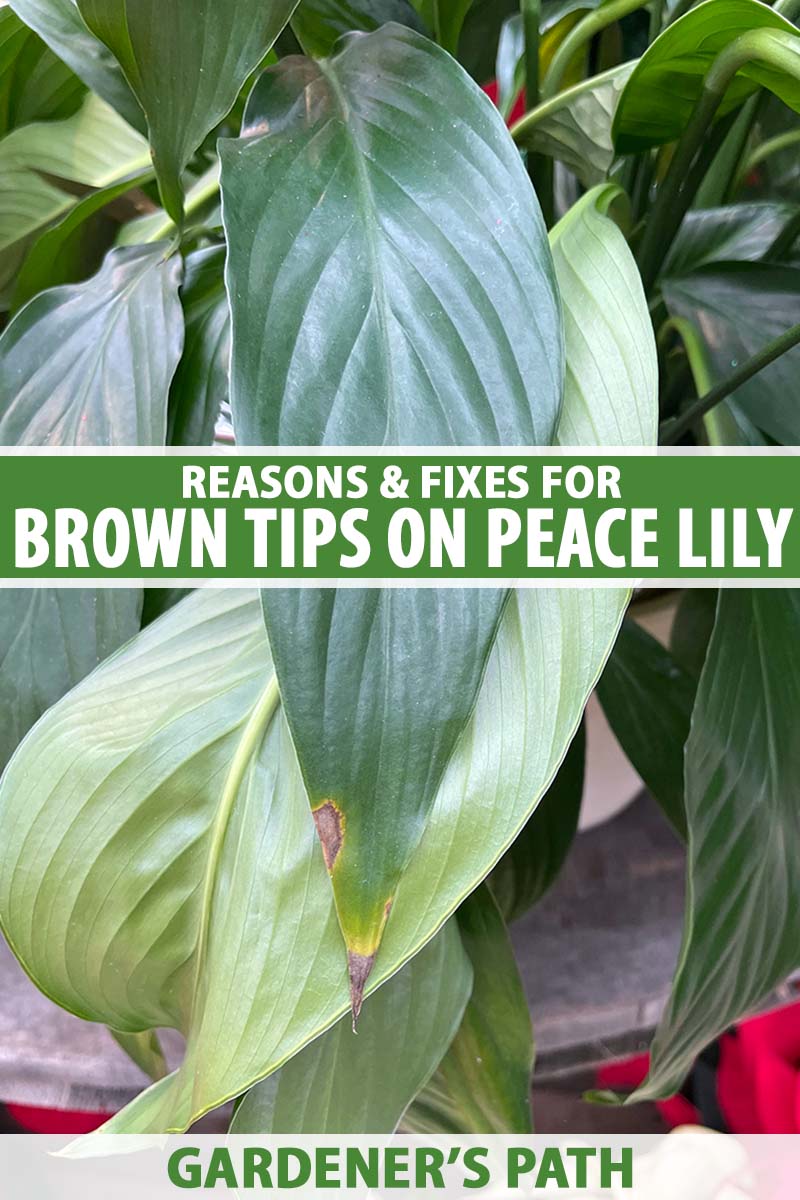
We link to vendors to help you find relevant products. If you buy from one of our links, we may earn a commission.
There are a number of reasons that may cause the leaf tips to turn brown, and in this guide we will go over the most common ones.
Here’s what we’ll discuss:
5 Causes of Brown Leaf Tips on Peace Lilies
Peace lilies are tropical plants that hail from warm, humid areas of Mexico, South America, and Southeast Asia. They do best in a location with bright, indirect light, temperatures between 60 and 85°F, and at least 50 percent humidity.
That said, they’re pretty robust and they can survive just fine if the temperatures wander out of this range or if your home’s humidity levels leave something to be desired.
However, when conditions are less than ideal, the tips of the leaves might start to turn brown. Unfortunately, once this happens, the tips won’t turn green again.
If you don’t like the appearance of the brown tips, you can either trim off the entire leaf, and wait for new foliage to replace it, or snip off just the tips.
Let’s take a look at five top reasons for brown leaf tips and get your peace lily back on track.
1. Moisture Stress
A common cause of brown tips on peace lilies is problems with hydration.
Too Much Water
Plants that receive too much water aren’t able to access the oxygen they need. The roots absorb oxygen from the air spaces in the soil, and if the soil is oversaturated, your peace lily’s roots can’t breathe.
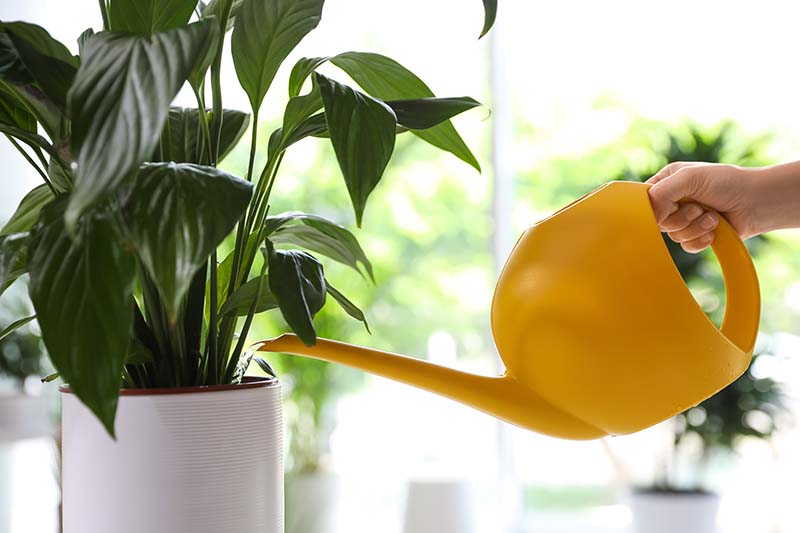
It’s easy to assume that if oversaturated soil is the problem, all you need to do is water less frequently, but that might not be the solution.
A plant can also be overwatered if the soil doesn’t drain quickly enough, or if it is growing in an excessively large container. Peace lilies tend to do better when they are slightly root bound rather than growing in a pot that is too large.
The reason for this is that it’s difficult to provide enough water to the plant without oversaturating the surrounding soil. The extra soil in a large pot holds water and is slow to drain, causing the roots to sit in consistently soggy soil.
The top inch of soil should be allowed to dry out between waterings, but that isn’t always a reliable indicator. Sometimes the soil below the top inch can remain extremely moist even as the top dries out.
Use a soil moisture meter to test the soil in the bottom half of the pot as well. You can add water when the meter indicates that the soil is on the dry side.
If you’re having trouble maintaining the right moisture level, consider repotting into a smaller container, if yours is too big, or repotting in soil with added perlite or rice hulls. This will help to improve drainage while still retaining water.
You can pick up a quarter-, half-, or one-cubic-foot bag of rice hulls at Arbico Organics.
Poor Drainage
If the container has poor drainage, even if you are offering your plant the right amount of water it’s likely that the roots are sitting in oversaturated soil for far longer than they should.
There are a lot of pretty containers out there that lack drainage holes, and I know how tempting it is to select one of these for your peace lily. Trust me, I’ve tried to get away with growing houseplants in solid containers more times than I care to admit.
In the long run you really are better off with a container that has at least one drainage hole in the bottom. Alternatively, you can use a well-draining container tucked inside a decorative cachepot.
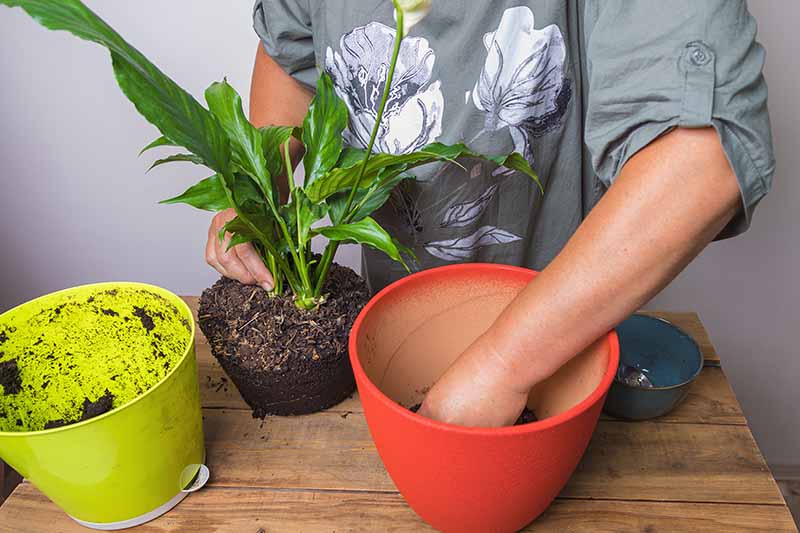
Even if your pot does have one or more drainage holes, check to make sure they aren’t blocked. Just stick your finger or a chopstick up there and move it around. If you encounter resistance, remove the plant from the container and see if it is root bound. In this case, loosen the roots and repot in a slightly larger container.
If you don’t need to go up a pot size, remove any rocks and loosen any clumps of soil that might be blocking the drainage hole before replacing the plant in the same pot.
In addition, after watering, always empty any saucer, pot, or other catchment at the base of the container.
Too Little Water
Too little water is just as much of a problem for your peace lily as oversaturation.
Deprived of the moisture it needs, the plant will become stressed, which can cause dry, crisp leaf tips. If you see drooping or wilting along with the browning tips, you can be fairly confident that too little moisture is the problem.
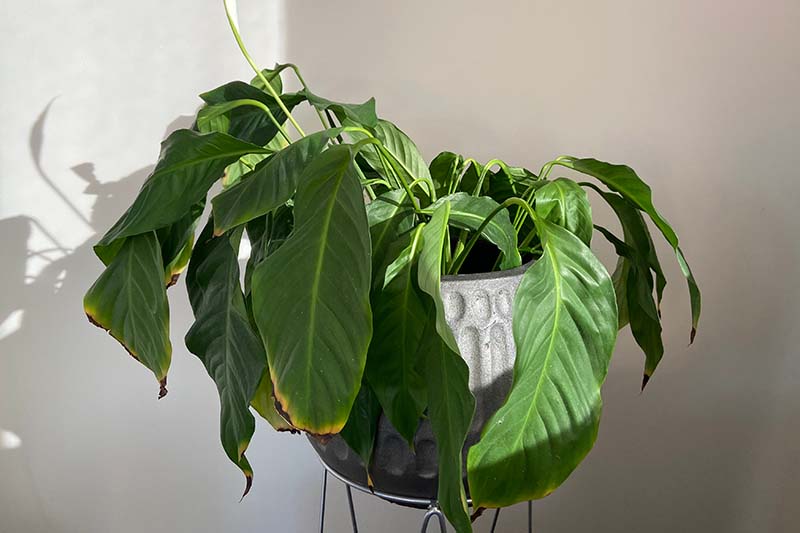
This problem develops after repeated underwatering or allowing the plant to become dehydrated, so don’t feel bad if you underwater your plant occasionally. Just take care to check the top inch of soil every few days and add water when it feels dry.
If you feel like the soil is drying out too quickly, try working some rice hulls or perlite into the potting medium.
A Note on Bottom Watering
Bottom watering can be an effective way to hydrate your plants, but this method can also result in a buildup of sodium in the soil. When you water from above, sodium is flushed out as the water drains through the potting medium.
If you do use the bottom watering technique, make sure that you water your plants from above every fourth or fifth time to flush out any excess sodium.
Give the soil a good, deep soaking and then dump the catchment saucer after 10 minutes and again in another 30 minutes, if necessary. If you do this regularly, it should be enough to keep the sodium from building up in the soil.
To further prevent an excess of sodium in the soil, never water with softened water, and refresh the soil in the container every few years.
Learn more about how to water your peace lily in our guide.
2. Temperature Extremes
Peace lilies generally aren’t fussy, but like all types of plants they require a specific temperature range to survive and thrive.
These plants do love a nice, toasty environment – but there can be too much of a good thing. Conversely, they will suffer if it becomes too cold (I know how they feel).
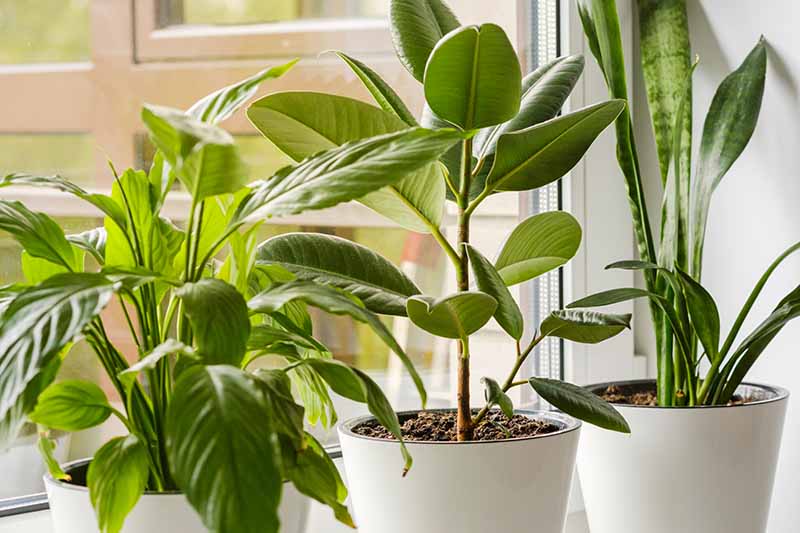
Consistent temperatures above 80 and below 65°F can cause the plant to become stressed, and the leaves to start turning brown at the tips.
If it’s too hot, the solution is to either move your plant to a cooler location away from windows with direct sun exposure, or crank up the AC during heatwaves.
Be sure to keep plants away from heat vents during the winter, as well. Not only is it hot near the vents, but the forced air dries out the foliage and soil more quickly.
If the temperatures are too cold, it’s a good excuse to turn up the heat during the winter, though you don’t have to rely on heat alone. Consider moving the plants away from windows or doorways, and don’t leave them near an AC vent in the summer.
3. Lack of Humidity
Peace lilies come from tropical areas that are warm and humid. If they don’t receive the humidity that they’ve evolved to thrive in, the tips of the leaves may turn dry and brown.
Fortunately, there are lots of ways to increase humidity. You can move your plant to the bathroom so it can enjoy the heat and moisture of your daily shower, or group a collection of houseplants together so they can raise the humidity level around them.
An easy way to increase humidity around your plant is to use a tray filled with pebbles and water. Place the plant on the tray and the humidity from evaporation will help keep those leaves green and glossy – just remember to top up the water regularly.
You can also spritz the foliage once or twice a day with a spray bottle, though this is a fairly time-consuming option.
If you go this route, you might consider investing in a plant mister to make the job quick and easy.

The Vivosun pressure sprayer holds 27 ounces so you can spray multiple plants at one time. Grab one for yourself at Amazon.
Or, if you would like something a little more decorative, check out this gorgeous copper mister, available at Terrain.
Then, turn humidifying time into your personal recharging time by slapping on some headphones, turning on your favorite music, and enjoying the process!
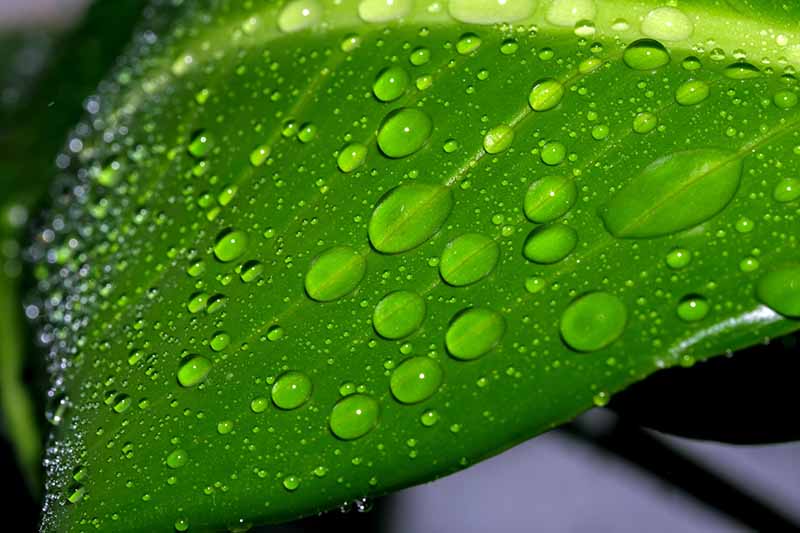
Alternatively, you can purchase a humidifier to increase the overall humidity in the room. Heck, it can help increase the moisture level in your skin, too, so why not?
4. Overfertilizing
When you give a plant too much fertilizer, this can result in a build-up of sodium and other salts in the soil. Since peace lilies need very little fertilizer, it should be fairly simple to avoid this problem – but that doesn’t mean it can’t happen.
As discussed, watering from the top, rather than the bottom, can help flush out excess salt from the soil. Careful fertilization practices help, as well.

Fertilize once a month during the spring and summer using an all-purpose indoor plant food like Miracle-Gro’s Indoor Plant Food, which is available at Amazon in two-packs of 21-ounce bottles.
Rather than applying the fertilizer full strength, dilute it by half, and don’t fertilize your plants at all during the fall and winter.
If it’s too late and you’ve already applied too much fertilizer, you’ll need to remove the plant from its container and knock away as much of the potting medium as you can. Then, repot in the same or a new container with fresh soil.
5. Sun Scorch
If your peace lily is kept in a location where it receives direct sun, it may experience sun scorch. This often starts at the tips of the leaves, which will turn brown and dry.
The brown patches may continue to extend further down the leaf unless you change the sun exposure.
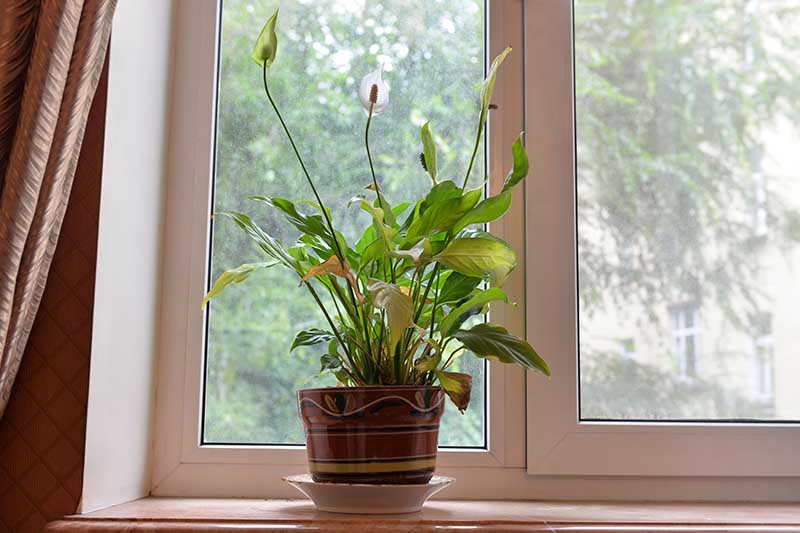
This is perhaps the easiest problem to solve – simply move the plant to a spot where it will receive a bit less light.
If you like the plant’s current location, consider hanging sheer curtains over the window to reduce the amount of light coming in.
A window with northern exposure is usually fine, but any other window without some sort of curtain or blind likely receives too much sun for the good for your peace lily.
Return Those Peace Lilies to Their Former Glory
Despite the fact that there are many causes of brown tips, it’s generally an easy problem to solve.
All it takes to avoid the situation in the first place is to provide your plant with appropriate light, water, humidity, and food. If you need a refresher on how to grow peace lilies, check out our guide.
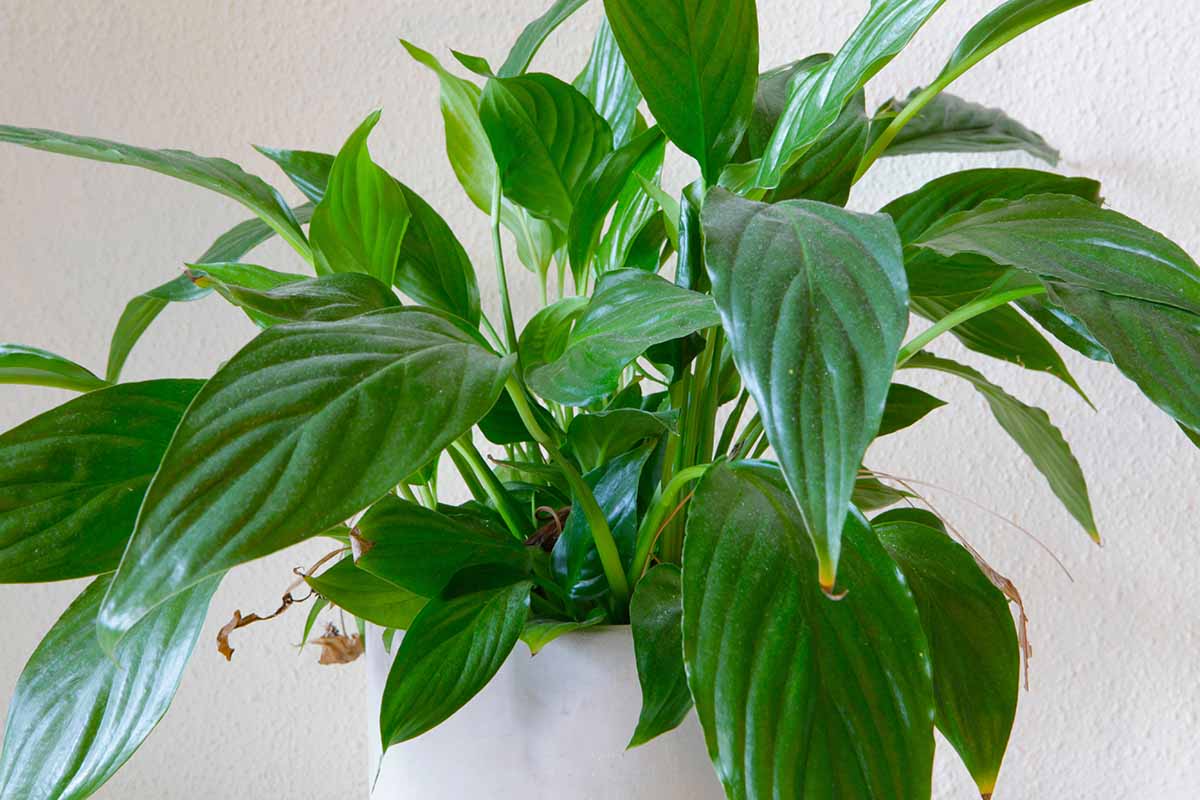
Is your peace lily suffering from brown leaf tips? Have you figured out the cause? Let us know in the comments section below.
Then, if you want to expand your peace lily knowledge, we have a few other guides that might be of use, including:

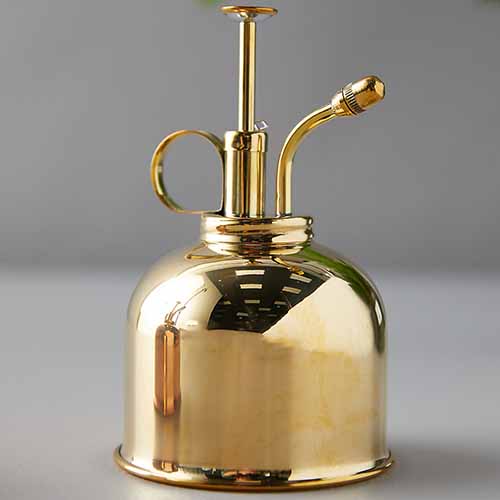



I have my peace lily outside for the summer; temps have reached high 90s for the past few days. It gets watered frequently, room temp, no chlorinated water. Leaves are turning brown, but I still have new growth and blooms. Is it too hot for the plant?
Hi Samantha! I would say that yes, it is probably hotter than your plant prefers. That doesn’t mean you have to bring it in, but just know that the leaves might burn. It will likely send up new foliage to replace any damaged leaves as the temperatures cool down a bit.
Hi! I’ve put peace lilies in the top water of largish vases holding beta fish. They were set a ways away from a western window. They and the fish did really well until I went on a trip and neglected to tell my pet sitter to check on them and the whole setting died. I’m planning to put lilies in with my betas again as the fish water seemed to really help the plants and the plants seemed to keep the water cleaner longer. Is there any way I could maybe improve the situation (besides finding a new pet sitter… Read more »
Oh no, I’m so sorry Keli! What a sad loss. Fish and plants go together well, they keep each other happy. Since peace lilies aren’t true aquatic plants, you need to be sure that only the roots are submerged. The stems and leaves need to be above the water. Otherwise, they’ll eventually rot and the plant will die. Don’t forget fertilizing. It sounds like you had a great set-up and just ran into a bad situation. Better luck with your next set-up!
This set up is horrible for a betta fish as they really need to be able to reach the surface to breathe. If someone insists on doing this, absolutely do not add fertilizer. You are guaranteeing the fish death by poisoning.
Hi JZH, you’re absolutely right, some fertilizers will kill fish. I should have been more clear in my comments. While fish can add natural fertilizer to the water, some people still find that they need to add food in the form of fish-safe fertilizer. Depending on the size of the container fertilizer might be necessary to supply the plant with enough nutrients. It’s not clear from the original post whether the fish has access to the surface of the water, but, of course, it’s always necessary for a betta to be able to reach the surface. Many plant/vase setups allow… Read more »
There is fertilizer available for aquarium plants that would be beneficial and safe.
Why would you have to find a new pet sitter? Unless you don’t like her for other reasons, just ask her to take care of plant & fish while you’re gone.
Hi,
I don’t have brown tips, I have large dark brown wrinkled up leaves but mainly only on one side of the plant….the side facing away from the window. North window. The “arms” are bending too. I have run into this before with Peace Lilies and have ended up cutting them all the way back and starting over.
Any suggestions?
I’ve dealt with this as well, and it sounds like you may be seeing symptoms of root rot. See our guide to peace lily diseases for more info. You’ll need to check the roots, trim away the damaged portions, repot to ensure good drainage if this is the culprit, and be sure to water mindfully moving forward – the guides linked to here will provide instructions and tips. With a little luck, you’ll be able to save your plant!
I don’t know what I’m doing wrong and what my lily is trying to tell me. I have one which was left outside on the balcony and it loved it even if the temperatures started getting a bit cooler. But suddenly, after weeks of loving it, it just got yellow and then brown but the leaves are plump, not shriveled or dry, and the leaves show the veins. What am I doing wrong? I’ve taken it indoors a week ago but the leaves continue to yellow. The whole plant is now yellow and the leaves are turning a light brown… Read more »
Hi there! It looks like you have a couple of “true lilies” there, not peace lilies, which is what this guide is about. True lilies are plants in the Lilium genus. I’d guess that these are some kind of L. orientalis hybrid. The good news is that this browning you’re seeing is probably totally normal. These plants die back at the end of the growing season. Give them a little bit of water, but less than you have been during the growing months, and allow the leaves to fall off naturally. They’ll return next year. You might be interested in… Read more »
My lily flowered but those turned brown. Decided to remove and look at roots. Learned nothing. My leaves do not droop only turn brown. Finger in top says water but an instrument Inserted tells me bottom portion is damp. Have 3 drain holes. Help!
Hi Beverly, I’m sorry to hear you’re having trouble. Are the brown areas soft and pliable? Or do they feel dry and crunchy? The first problem is almost certainly overwatering, especially if the bottom portion of the soil is consistently damp. In that case, you could be overwatering or you need to empty the catchment after watering. If the brown areas feel dry, it could be a problem with dry air, in which case, you need to increase humidity.
I have a Peace Lily that I keep in the bathroom. One leaf is turning brown, and a flower is nearly dead. Any suggestions? ????
Hi Zara, peace lily flowers don’t last terribly long. They turn brown and fade after a few weeks, so if it has been that long, I wouldn’t worry about it. As far as the brown leaf, is it just the tip? Is the whole leaf turning brown? If it’s the whole leaf, I’d check the moisture in the soil. I personally find that it’s best to wait until the leaves just begin to droop before I water. Otherwise, I tend to overwater. The extreme temperature fluctuations in some bathrooms can cause leaf tips to turn brown. If you’d like to… Read more »
Hi, my peace lily constantly has brown tips and often new leaves are affected shortly after coming through. I have it on top of my tropical fish tank and this gets quite warm due to the heat from the fluorescent lights. Could this be affecting the plant and not be a suitable spot?
Hi Linda, it all depends on how hot the soil is getting. If the soil is heating up above 75°F, then yes, this could be the cause of the brown leaf tips. Try moving it to a different spot or placing something in between the pot and the light to block the heat. Give it a few months and see how the new leaves look.
Hello, I have a Peace Lily that was cut down to almost the dirt by a very unhappy student. Is there hope for this poor plant to regrow? Thank you for any advice you can give.
Oh no, I’m sorry! It’s possible that it will regrow. If it was healthy before it was cut and the roots are still in good shape, it might start sending up new leaves. To support it, reduce your watering because the roots won’t be taking up as much moisture. If you stick your finger in the soil, it should be dry to the first knuckle before you water. Better yet, use a moisture meter and water when the soil reads right on the edge of dry and moist.
Yes the leaves on my peace lily are turning brown on the ends. I have it in a hallway on a sofa table. I did have it at the end of the table where a heat vent is but I moved it to the other side of the table but it is close to a door that goes into the garage. Is this ok?
Hi Kyle, you’re probably better off with the plant closer to the garage than a heat vent. Garages usually bugger the house from the outside air, so your peace lily should be fine. You might need to adjust your watering now that it isn’t near the heat vent and probably won’t be drying out as quickly as it used to be.
Thank you for the article and answered questions. I thought the best fertilizer for peace lilies is 3-1-2 formulation.
Hi Barbara, I find that a balanced formula is best, but feel free to try 3-1-2 out. Just be careful not to overfeed.